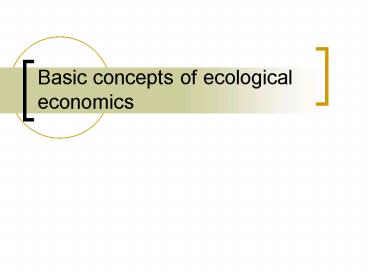Basic concepts of ecological economics - PowerPoint PPT Presentation
1 / 17
Title:
Basic concepts of ecological economics
Description:
Natural capital ... Natural resource stocks cannot be aggregated into one measure. Other forms of capital cannot always substitute for depletion of natural capital ... – PowerPoint PPT presentation
Number of Views:150
Avg rating:3.0/5.0
Title: Basic concepts of ecological economics
1
Basic concepts of ecological economics
2
Natural capital
- The whole endowment of land and resources
available to us, including air, water, fertile
soil, forests, fisheries, mineral resources and
the ecological life support systems.
3
Value of capital
- Capital stocks are the basis for generating flows
of income through production of goods and
services - Increasing size of capital stocks increases
potential income flow
4
Accounting for change in capital
- Depreciation wearing out, depletion, obsolesce
- Investment producing new capital
- New construction
- New machinery
- Planting trees
- Discovery of new mineral stocks
5
Accounting for scale
6
Sustainable development
- There are hundreds of definitions of sustainable
development. - Sustainable development means different things to
different people - The starting point for most people has been the
definition prepared by the World Commission on
Environment and Development (the Brundtland
Commission) in its report Our Common Future
(Oxford Oxford University Press, 1987)
Sustainable development is development that meets
the needs of the present without compromising the
ability of future generations to meet their own
needs.
7
Sustainable development
- Sustainable development focuses on improving the
quality of life for all of the Earth's citizens
without increasing the use of natural resources
beyond the capacity of the environment to supply
them indefinitely. http//www.sdgateway.net/intro
sd/definitions.htm
8
Ecological economics measures of sustainability
- Net primary production ability to capture
photosynthetic energy - Resilience ecosystem capacity to recover from
adverse impact - Substitutability of human made capital for
natural capital
9
When is development sustainable?
- Two sustainability criterion
- Weak sustainability humanmade capital can
perfectly substitute for the loss of any natural
capital - Strong sustainability limits to the substitution
of humanmade capital for natural capital losses
10
Weak sustainability criterion
- Development is sustainable so long as genuine
capital growth occurs - Genuine capital growth occurs when investment in
new capital depreciation of physical capital
depletion of natural resource stocks
environmental degradation
11
Weak sustainability criterion
- Investment can include
- New physical capital
- RD to improve productivity of physical capital
- Education to improve productivity of human
capital - Exploration for discovery of new stocks of
natural resources
12
Solved problem
- GDP last year was 12 trillion, including
- 2 trillion in new capital,
- 1 trillion in RD,
- 500 billion in exploration and development of
new natural resource stocks and - 3 billion in human capital improvement.
13
Solved problem
- Last year the economy incurred the following
expenses in producing the 12 trillion GDP - 2 trillion in depreciation of physical capital,
- 700 billion in depletion of natural resource
stocks and - 500 billion in the degradation of the
environment. - Did the economy experience genuine growth?
14
Strong sustainability criterion
- Strong sustainability criterion based on
recognition that - Natural resource stocks cannot be aggregated into
one measure - Other forms of capital cannot always substitute
for depletion of natural capital - Development will be constrained by the most
limiting factor
15
Strong sustainability criterion
- Strong sustainability principles
- Maintain level of flows from renewable resources
- Maintain flow of income from non-renewable
resources - Safe minimum standard
- Limits to environmental resilience
- Precautionary principle
16
Safe minimum standard
- Safe minimum standard
- The principle that environmental policies on
issues involving uncertainty should be set to
avoid possible catastrophic consequences.
The reactor plant at Chernobyl
17
Precautionary principle
- Minimum interference with the operation of
natural systems given - Ecological complexity
- Potential irreversibility
- Scientific unknowns































